Drug addiction vs. drug abuse
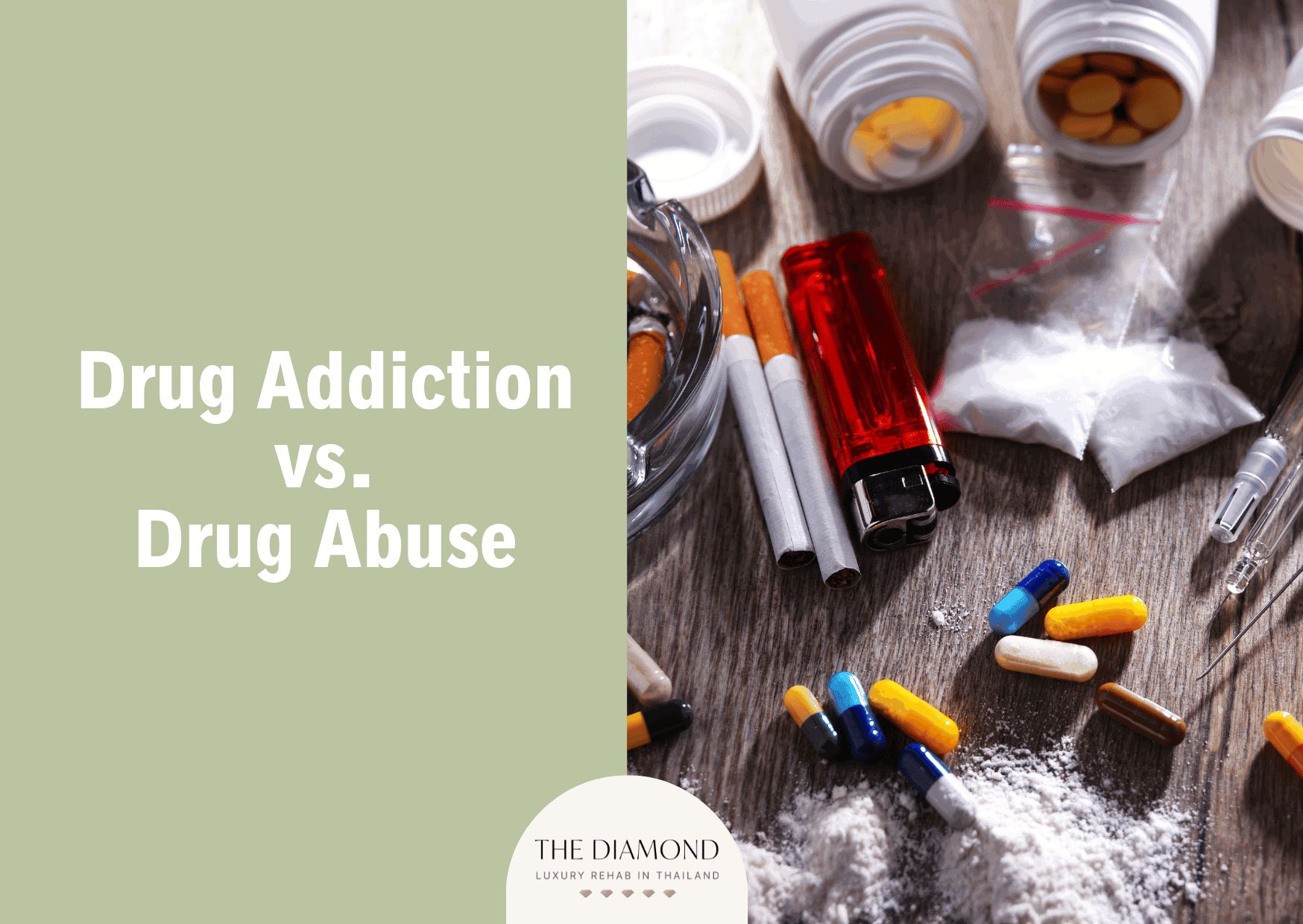
Drug addiction is the compulsive use of a drug or substance, despite its dangers. On the other hand, drug abuse is the act of using illicit substances or prescription medications in ways other than intended or using drugs to achieve euphoria or “high.” Substance abuse vs. addiction differs primarily in the extent of the use and its consequences on mental or physical functioning.
While the terms drug addiction and drug abuse are sometimes used interchangeably, they’re not the same. A person with drug addiction can’t stop using a specific substance that easily. When they try to do so, they experience cravings or withdrawal symptoms. On the other hand, a person who abuses a drug can stop taking it.
Both drug addiction and drug abuse manifest themselves through a wide range of symptoms that can be mild to severe. The main difference between abuse and addiction, however, is that the latter is more dangerous and leads to disastrous effects.
They also need adequate treatment. Drug addiction treatment usually combines medications and therapy. Support groups can be helpful too. Drug abuse also requires treatments in order to prevent it from progressing into an addiction. It’s useful to mention that not every case of drug abuse leads to addiction.
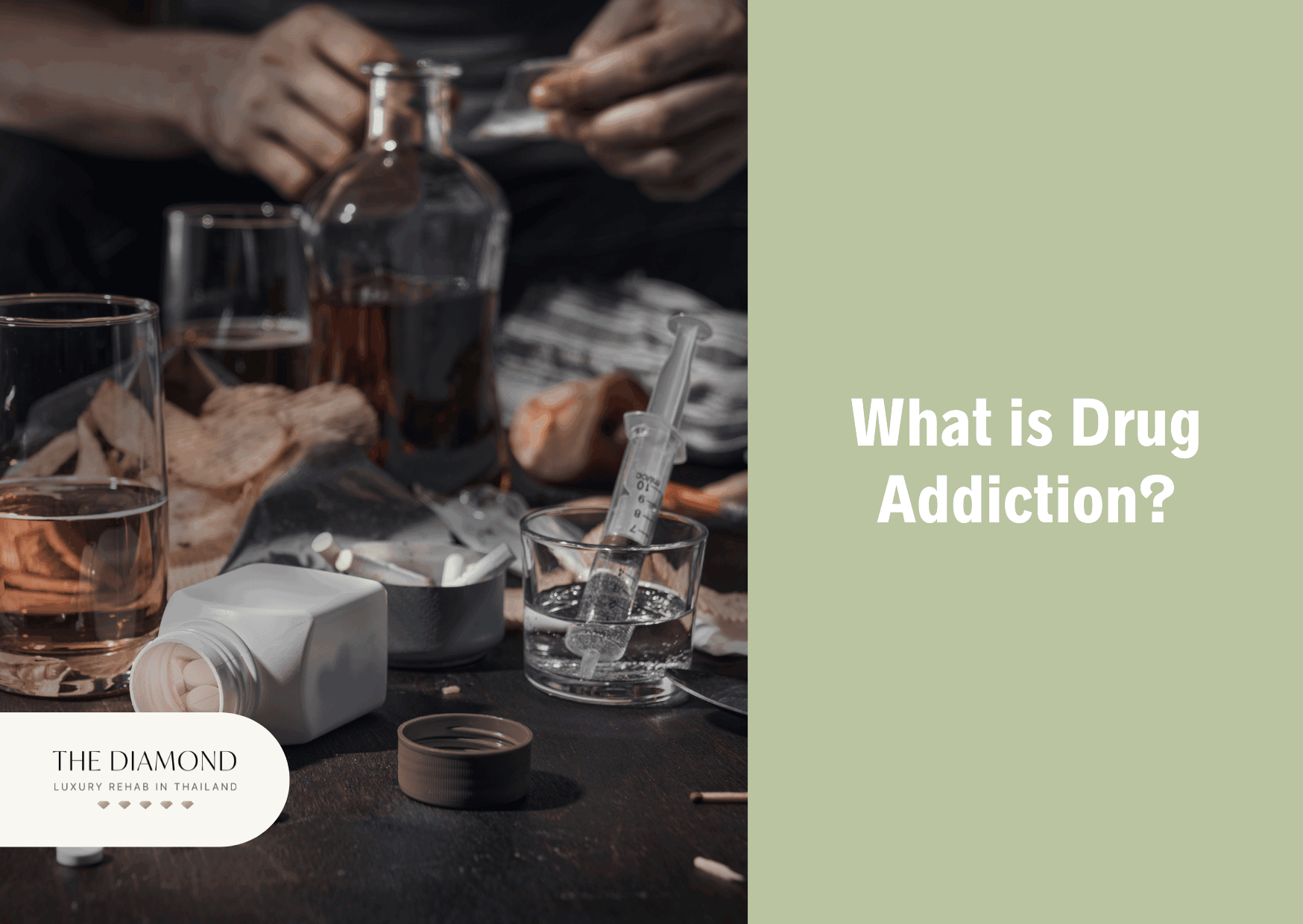
What is drug addiction?
Drug addiction is a compulsive need to keep taking a certain drug or substance, regardless of the consequences and risks they cause. If a person attempts to quit, they experience withdrawal symptoms and cravings that make them start using the drug again.
A patient with a drug addiction needs professional help to recover successfully. This is the main point of difference between drug abuse and drug addiction. As a mental health problem, drug addiction affects a person’s brain and behavior.
It often starts with the experimental use of recreational drugs. For some people, recreational use becomes more frequent to the point they start abusing the substance and pave the way to addiction. The development of drug addiction has a lot to do with genetics and the environment.
Drug addiction is formally classified as a substance use disorder in the Diagnostic and Statistical Manual of Mental Disorders, Fifth Edition (DSM-5). Young males are most likely to develop drug addiction. For example, 22% of males and 17% of females misused prescription drugs or used illegal drugs within the past year, according to data on drug abuse from the National Center for Drug Abuse Statistics.The same report also shows that 37.309 million Americans are current illegal drug users as of 2020. Since 2000, around 700,000 drug overdose deaths have occurred in the United States.
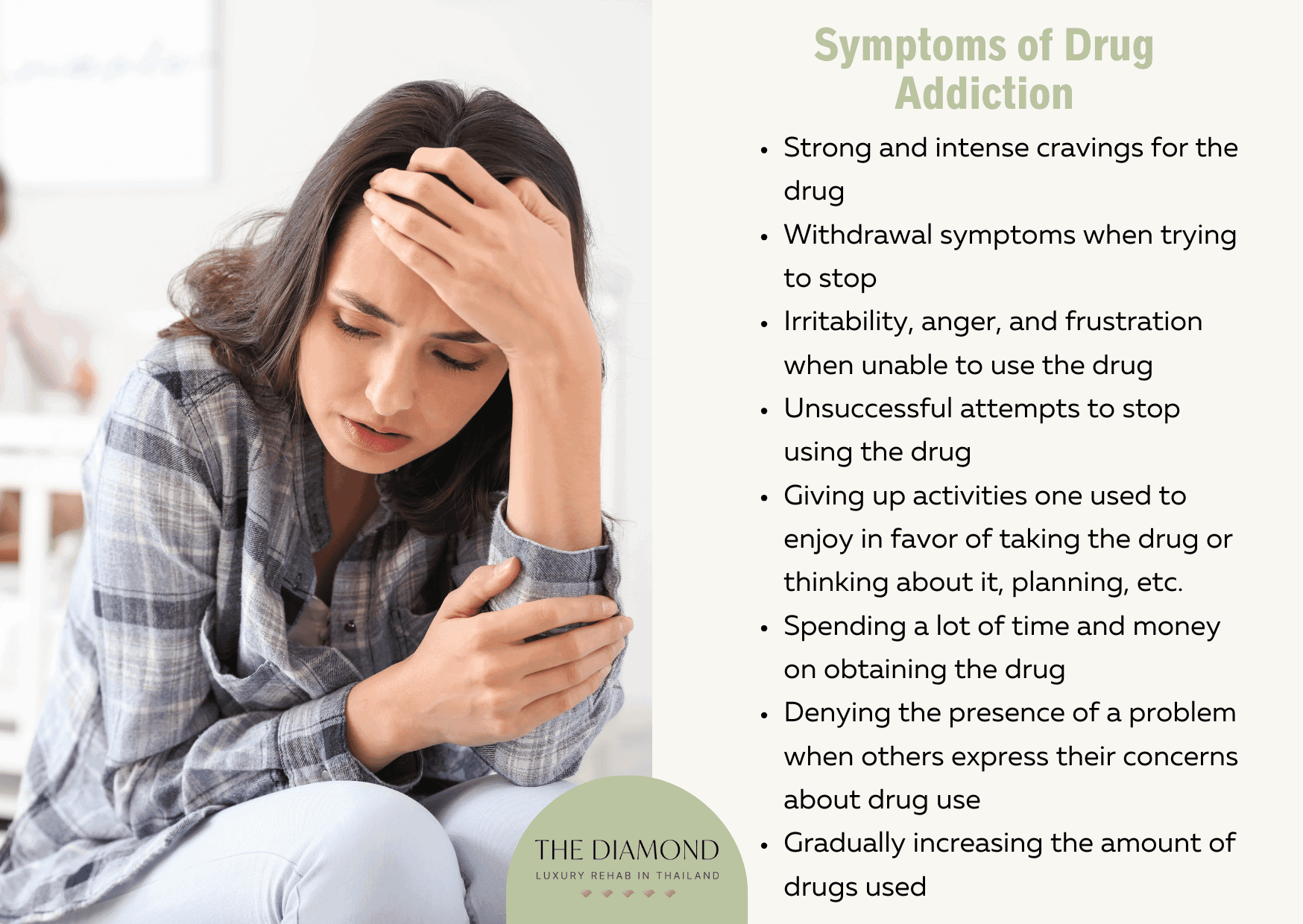
What are the symptoms of drug addiction?
Symptoms of drug addiction refer to a variety of behavioral, psychological, and physical cues that point to a person’s dependence on and addiction to a certain substance. The common symptoms of drug addiction are listed below.
- Strong and intense cravings for the drug
- Withdrawal symptoms when trying to stop
- Irritability, anger, and frustration when unable to use the drug
- Unsuccessful attempts to stop using the drug
- Giving up activities one used to enjoy in favor of taking the drug or thinking about it, planning, etc.
- Spending a lot of time and money on obtaining the drug
- Denying the presence of a problem when others express their concerns about drug use
- Gradually increasing the amount of drugs used
- Feeling strange when the drug wears off
- Having a hard time controlling oneself
- Having trouble with everyday activities due to drug use
- Borrowing or stealing money to pay for drugs
- Not getting along with coworkers, friends, and family members due to drug problem
- Socializing with people who also use specific drugs and become addicted to them
- Changes in personality and behavior due to drug addiction
- Financial and legal problems due to drug addiction
- Deteriorating health due to drug addiction
- Changes in appetite and appearance
- Difficulty keeping up with assignments at school or work
As seen above, drug addiction has a wide spectrum of symptoms that may range from mild to severe. Other symptoms of drug addiction also include:
- Becoming defensive, argumentative, and disinterested in everything they used to enjoy
- Changing social circle and starting to spend more time with people who also abuse drugs or develop drug addiction
- Deciding to quit using drugs, but fails due to strong withdrawal symptoms and cravings
- Exhibiting changes in behavior, appearance, and both physical and psychological health and wellbeing
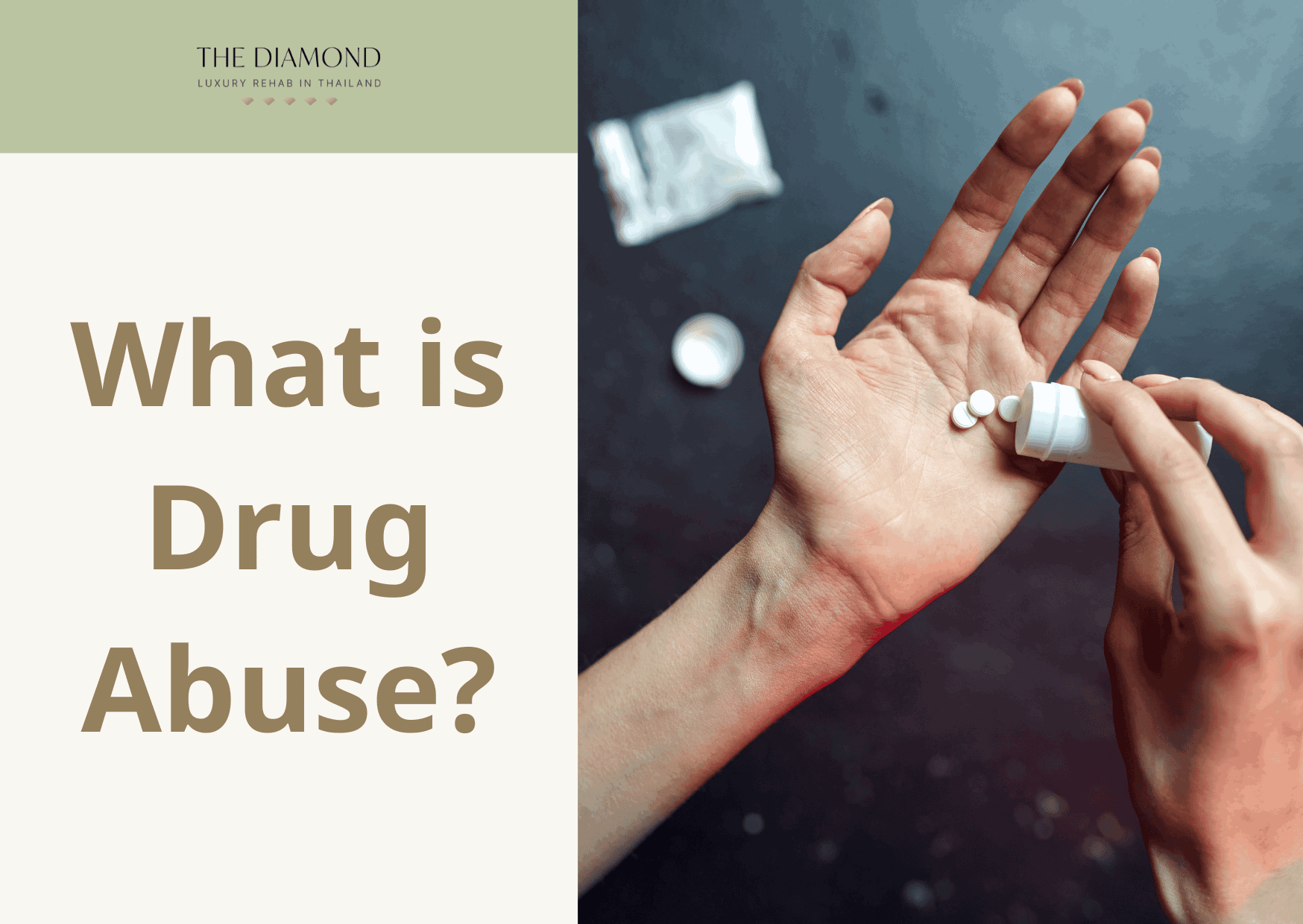
What is drug abuse?
Drug abuse is excessive and maladaptive use of prescription or illicit drugs for the purpose of creating pleasurable effects on the brain. In other words, the term drug abuse doesn’t just refer to the use of illicit or illegal substances. It also refers to the use of prescription medications outside of their intended purpose.
A person with drug abuse isn’t necessarily addicted to these substances. At this point, they can still stop using the drug, when they decide to do so.
What are the symptoms of drug abuse?
Symptoms of drug abuse vary depending on the specific drug used by the affected individual. The common symptoms of drug abuse are listed below.
- Problems at home and school/work due to drug abuse
- Using drugs in a way they aren’t intended
- Interrupted sleep patterns
- Continuing using drugs despite the risk and problems they cause
- Feeling that you have to use it regularly, even when it’s not necessary
- Spending a lot of money on drugs
- Considering or actually engaging in risky behaviors to obtain drugs
- Bloodshot eyes
- Sudden weight loss
- Changes in skin health and appearance
- Poor motivation
- Mood swings and irritability
Drug abuse manifests itself through a wide range of symptoms. These signs and symptoms of drug abuse can be sorted into categories listed below.
- Physical changes (appearance, health)
- Behavioral changes
- Psychological changes
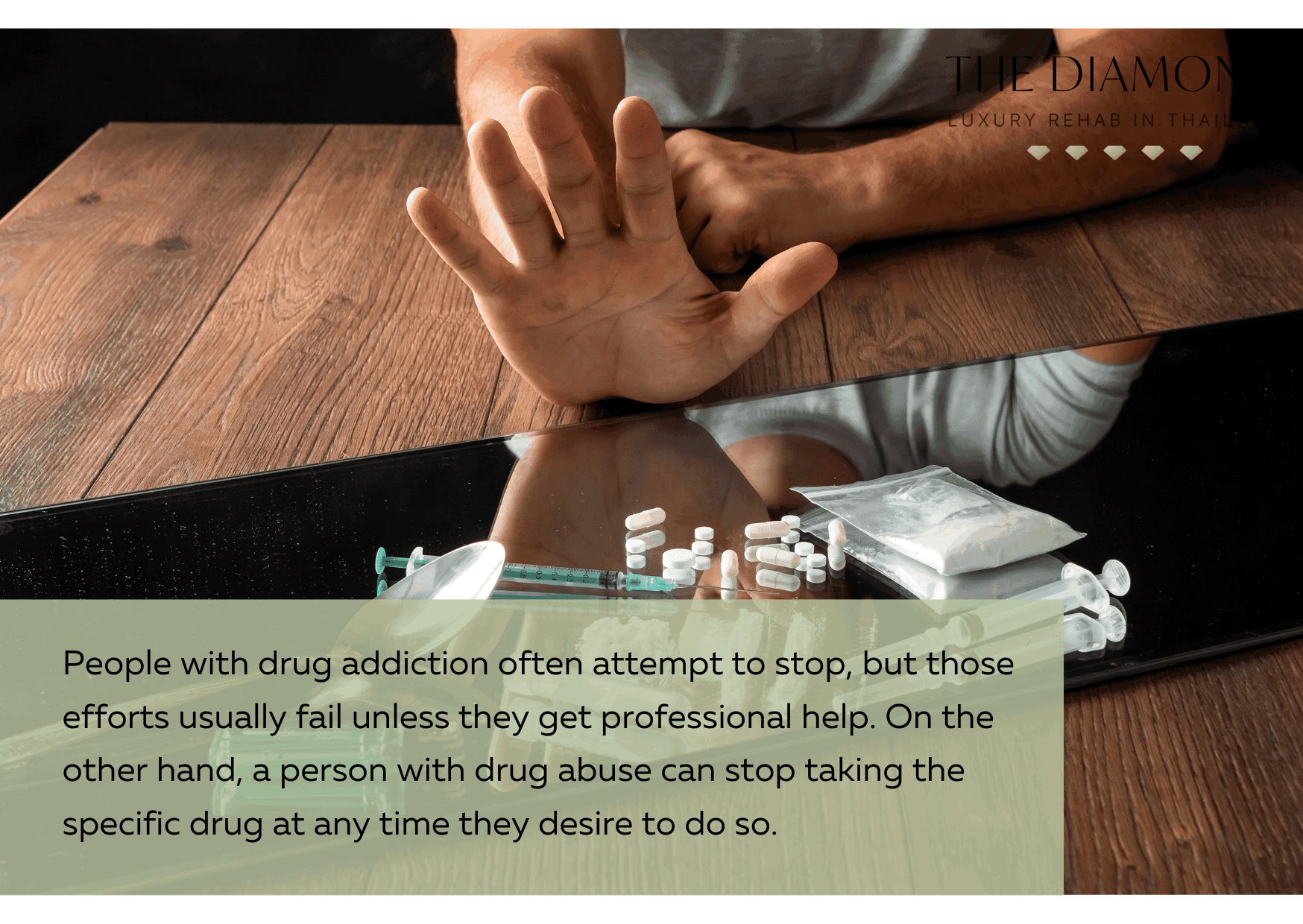
What is the difference between drug addiction and drug abuse?
The difference between drug addiction and drug abuse is that the latter is relatively easy to stop. The hallmark feature of drug addiction is the compulsive need to use drugs, despite the consequences.
People with drug addiction often attempt to stop, but those efforts usually fail unless they get professional help. On the other hand, a person with drug abuse can stop taking the specific drug at any time they desire to do so.
While drug addiction vs abuse aren’t the same things, abuse can lead to addiction. This happens when a person continues using the drug more frequently and in higher doses. However, it’s important to bear in mind that drug abuse can exist without addiction. A person can abuse a specific drug or substance without being addicted to it, the Substance Abuse & Addiction Resource Center of WebMD reports.
When we’re talking about drug abuse vs drug addiction, it’s important to mention that the DSM-5 published by the American Psychiatric Association contains criteria that classify addiction as a mental health condition called substance use disorder. A 2013 paper by Hasin et al., published in the American Journal of Psychiatry explains that DSM-5 combines abuse and dependence but features different criteria that explain the severity of the problem with drug abuse vs addiction.
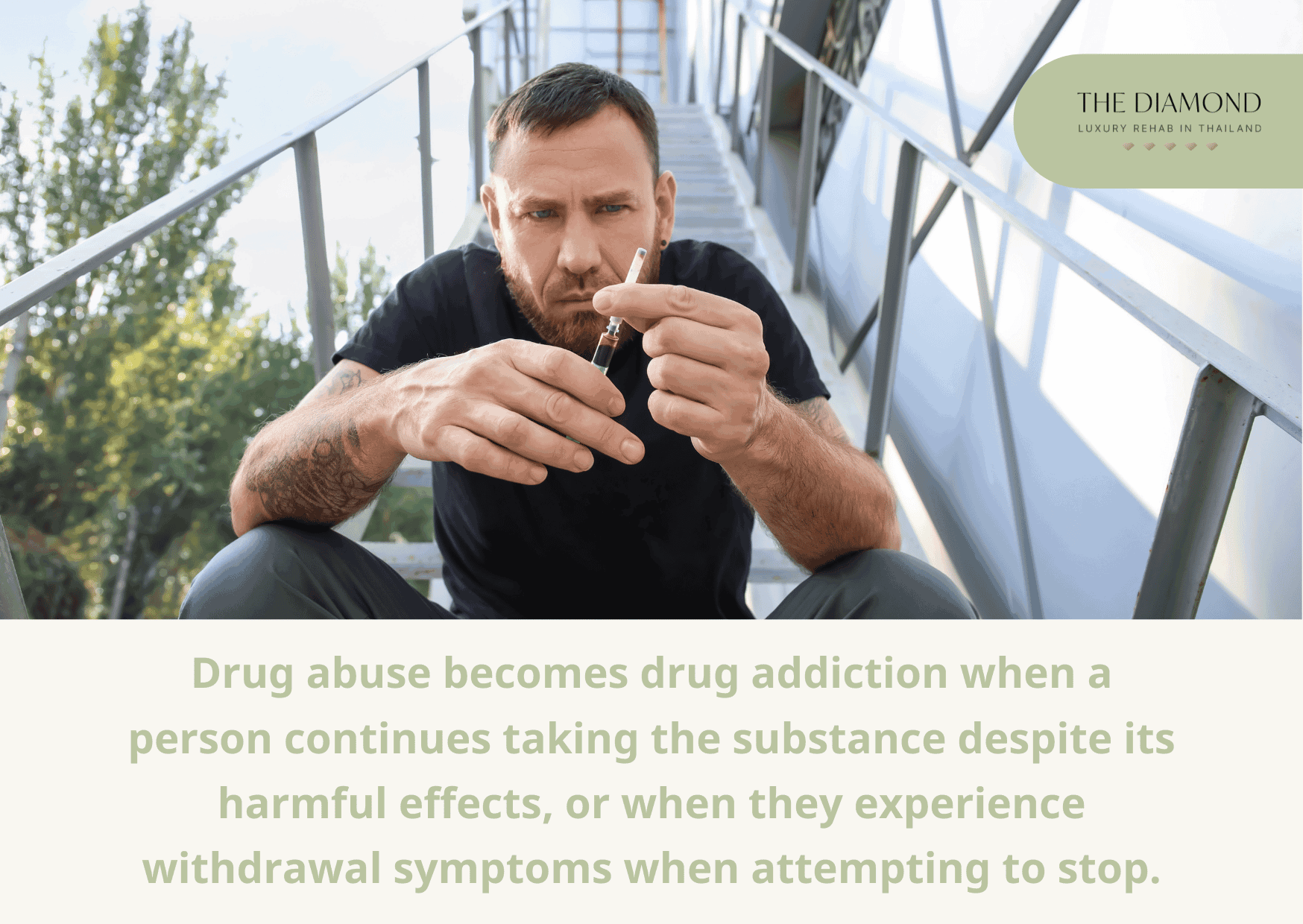
When does drug abuse become a drug addiction?
Drug abuse becomes drug addiction when a person continues taking the substance despite its harmful effects, or when they experience withdrawal symptoms when attempting to stop. According to a 2018 article titled, “Understanding Drug Use and Addiction DrugFacts” from the National Institute on Drug Abuse, various factors influence a person’s likelihood of developing drug addiction.
The more factors are involved, the higher the addiction risk. The most common risk factors include biology (genes, gender, ethnicity), presence of other mental health problems, environment (peer pressure, trauma such as physical or sexual abuse), and family history of drug addiction.
Most drugs act on the brain’s reward system; they cause euphoria, high, and other pleasurable emotions. This happens because these drugs trigger the release of dopamine, which regulates the reward system. For that reason, a person wants to keep using the drug to experience the same effects. Persistent use of drugs reduces the expression of dopamine receptors, meaning they need higher doses to experience the same feelings of euphoria. This leads to abuse and eventually addiction.
Evidence shows individuals who start abusing drugs early in life are more likely to develop an addiction later on.There is no specific timeframe within which drug abuse transforms into an addiction. Several factors are involved, including frequency of use, type of drug, and dosage, just to name a few.
Remember, not every person who abuses drugs will develop an addiction. However, drug abuse is still a serious problem that should be managed properly.
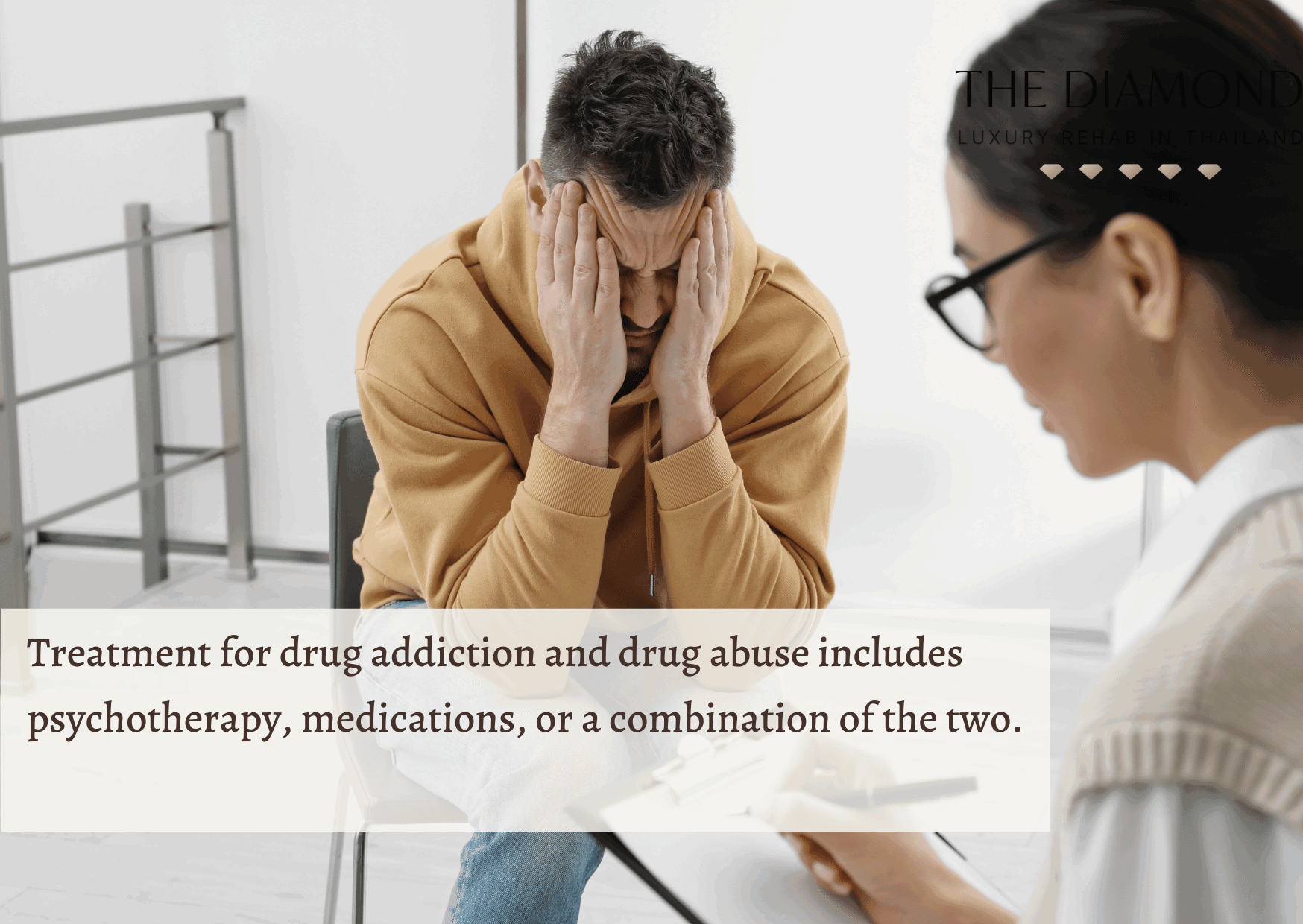
How to treat drug addiction and drug abuse?
Treatment for drug addiction and drug abuse includes psychotherapy, medications, or a combination of the two. The severity of addiction, type of drug abused, frequency, and dosage, are some of the most significant factors that determine the exact treatment approach.
The first stage of the treatment for drug abuse and addiction is called detox. At this point, a patient stops using the drug and usually experiences various withdrawal symptoms, including strong cravings. Detox is performed under medical supervision. Patients may get medications to reduce the severity of withdrawal symptoms; this is called medication-assisted treatment (MAT).
Medications usually prescribed in MAT include methadone, naltrexone, and buprenorphine. That said, medications are never the sole treatment method for drug addiction. The cornerstone of treatment for drug addiction or abuse is therapy such as cognitive-behavioral therapy (CBT), motivational interviewing, and other approaches.
The main goal of therapy is to help patients identify negative thoughts and behavior patterns that encourage drug abuse and addiction in order to replace them with more positive alternatives.
Moreover, therapies motivate patients to actively work on addiction treatment. They also provide strategies for coping with cravings and preventing relapse. Therapies also help patients handle relapse if it occurs. The benefits of therapies for drug addiction treatment also extend to improving communication skills, relationships, and quality of life.
A 2019 review by Ray et al., published in JAMA Network Open suggests that the combination of pharmacotherapy and psychotherapy could be the best fit for patients with drug addiction.
Another 2010 study on cognitive-behavioral therapy for substance use disorders from the Psychiatric Clinics of North America explains that CBT, which includes different approaches, is an effective strategy in the treatment of alcoholism and substance use disorders.
Drug addiction treatment is performed in an inpatient (residential) or outpatient setting. During inpatient treatment, patients live in a rehabilitation facility where they undergo medically-supervised detox and attend therapy sessions. This treatment program lasts 60, 90 days, or longer.
Outpatient treatment includes regular therapy sessions, but patients don’t live in the rehab center. They can go home every time. An outpatient program is suitable for patients with mild addiction or drug abuse, but also for those who have completed an inpatient program and want to support their recovery.
Besides individual therapy sessions in the treatment of drug addiction or abuse, patients can also attend group therapies, family therapies, and couple’s counseling.
Support groups such as 12-step programs also play a major role in the treatment of drug addiction or abuse. The Substance Abuse and Rehabilitation journal published a study by Kathlene Tracy and Samantha P. Wallace in 2016 that confirmed the importance of support groups in the treatment of addiction.
The support groups show much promise but also require further research. What makes support groups beneficial is that people with drug abuse or addiction get to listen to the experiences of men and women who are in the same situation. They also get support on their way to recovery but show support for others too.

How do drugs of abuse differ from medicines?
Drugs of abuse differ from medicines because they have no medical purpose. On the other hand, medicines prevent, cure, or aid the management of various illnesses and health conditions.
A drug of abuse is a specific substance or compound, whereas medicine is a pharmacological product that contains a form of a certain compound delivered through a specific dosage.
This subject is more complex than it seems, though. For example, the drug can be any chemical substance that acts on the body and alters physiological processes to treat, prevent, or manage some disease. Medicine is the formulated form of the drug.
More precisely, the term drug generally refers to an active pharmaceutical ingredient, whereas medicine is the formulation of that compound with or without excipients.
While drugs of abuse don’t have a suitable dosage and form, medicines do. Additionally, medicines are used for the treatment of specific health problems directly, while drugs of abuse are not. Drugs of abuse and medicines differ in terms of sources, too. For example, drug abuse may stem from plants, minerals, herbs, microorganisms, and other sources. The source of medicine is the drug with other additional chemicals or components.

